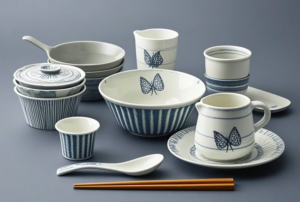Why do some consumers like to use melamine cutlery? You can see them at parties, restaurants, and even family gatherings because they are beautiful and durable. However, some high-quality melamine cutlery can be relatively expensive. Next, let’s understand why high-quality melamine products are expensive.
Why Is the Price High for Quality Melamine Products?
To understand why the price of Quality melamine cutlery is higher, it is important that we first learn about the main types of melamine. Normally, melamine products come in two main types: urea-based melamine and 100% melamine. These two materials differ significantly in terms of quality, durability, and overall performance, which is why the price is also different.
 Urea-based melamine normally consists of a combination of melamine resin and urea-formaldehyde. Although this combination results in lower costs, it also results in compromised product quality. This is because the urea-based melamine is more susceptible to discoloration and tends to absorb odors more easily. It may also have a more brittle structure, making it more prone to chipping or breaking with heavy use.
Urea-based melamine normally consists of a combination of melamine resin and urea-formaldehyde. Although this combination results in lower costs, it also results in compromised product quality. This is because the urea-based melamine is more susceptible to discoloration and tends to absorb odors more easily. It may also have a more brittle structure, making it more prone to chipping or breaking with heavy use.
On the other hand, 100% melamine is made from pure melamine resin which offers superior quality. This material is highly durable and better at maintaining its color and finish for a longer period. The pure melamine composition also provides increased strength which reduces the likelihood of breakage. Moreover, it also does not easily absorb stains or odors. As a result, 100% melamine cutlery tends to look newer for longer and easily withstands frequent or daily washing.
So, while the initial cost of 100% melamine tableware may be high, you are investing in long-lasting and aesthetically pleasing tableware that will maintain its value over time.
Price differences between regional factory melamine
One of the reasons why melamine products produced by factories in some regions are cheaper is the difference in materials used and manufacturing processes. Melamine production in some factories usually uses mixed or urea-based melamine, resulting in lower-quality products and lower production costs.
Another factor contributing to the price difference is the production standards and design focus in these regions. Some factories employ more sophisticated manufacturing processes and quality checks, as well as better product designs that cater to consumers looking for premium items. While this naturally results in a higher price, it also attracts consumers who prefer long-term value and aesthetics.
Design and development also contribute to the higher prices of melamine products since high-quality melamine platters often feature intricate patterns, detailed finishes, and unique designs that often mimic high-end porcelain or ceramic. These designs require careful development, often involving artists and designers who ensure the end product is visually appealing. The attention to detail and design refinement further add to the cost.
Meeting environmental and safety standards is one of the most important aspects when it comes to the production of melamine cutlery. Premium products are typically free from harmful chemicals like BPA and adhere to food safety standards. Complying with these environmental requirements means using better raw materials and ensuring a cleaner production process, both of which increase the overall cost.
